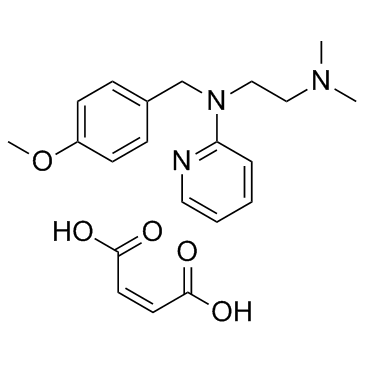Pyrilamine Maleate Salt

Pyrilamine Maleate Salt structure
|
Common Name | Pyrilamine Maleate Salt | ||
|---|---|---|---|---|
| CAS Number | 59-33-6 | Molecular Weight | 401.45600 | |
| Density | N/A | Boiling Point | 423.8ºC at 760 mmHg | |
| Molecular Formula | C21H27N3O5 | Melting Point | 100-101ºC | |
| MSDS | Chinese USA | Flash Point | 210.1ºC | |
| Symbol |

GHS07 |
Signal Word | Warning | |
|
Salt effects in electromembrane extraction.
J. Chromatogr. A. 1347 , 1-7, (2014) Electromembrane extraction (EME) was performed on samples containing substantial amounts of NaCl to investigate how the presence of salts affected the recovery, repeatability, and membrane current in the extraction system. A group of 17 non-polar basic drugs ... |
|
|
Olodaterol attenuates citric acid-induced cough in naïve and ovalbumin-sensitized and challenged guinea pigs.
PLoS ONE 10(3) , e0119953, (2015) Excessive coughing is a common feature of airway diseases. Different G-protein coupled receptors, including β2-adrenergic receptors (β2-AR), have been implicated in the molecular mechanisms underlying the cough reflex. However, the potential antitussive prope... |
|
|
Involvement of H1 and H2 receptors and soluble guanylate cyclase in histamine-induced relaxation of rat mesenteric collecting lymphatics.
Microcirculation 21(7) , 593-605, (2014) This study investigated the roles of the H1 and H2 histamine receptors, NO synthase, and sGC cyclase in histamine-induced modulation of rat mesenteric collecting lymphatic pumping.Isolated rat mesenteric collecting lymphatics were treated with 1- to 100-μM hi... |
|
|
Differential thermodynamic driving force of first- and second-generation antihistamines to determine their binding affinity for human H1 receptors.
Biochem. Pharmacol. 91(2) , 231-41, (2014) Differential binding sites for first- and second-generation antihistamines were indicated on the basis of the crystal structure of human histamine H1 receptors. In this study, we evaluated differences between the thermodynamic driving forces of first- and sec... |
|
|
Prothrombin activator-like toxin appears to mediate cardiovascular collapse following envenoming by Pseudonaja textilis.
Toxicon 102 , 48-54, (2015) Brown snake (Pseudonaja spp.)-induced early cardiovascular collapse is a life-threatening medical emergency in Australia. We have previously shown that this effect can be mimicked in animals and is mediated via the release of endogenous mediators. In the pres... |
|
|
Method development for impurity profiling in SFC: The selection of a dissimilar set of stationary phases.
J. Pharm. Biomed. Anal. 111 , 333-43, (2015) Supercritical fluid chromatography (SFC) is drawing considerable interest as separation technique in the pharmaceutical industry. The technique is already well established in chiral separations both analytically and on a preparative scale. The use of SFC as a... |
|
|
Effects of ONO-6950, a novel dual cysteinyl leukotriene 1 and 2 receptors antagonist, in a guinea pig model of asthma.
Eur. J. Pharmacol. 765 , 242-8, (2015) We assessed in this study the anti-asthmatic effects of ONO-6950, a novel cysteinyl leukotriene 1 (CysLT1) and 2 (CysLT2) receptors dual antagonist, in normal and S-hexyl glutathione (S-hexyl GSH)-treated guinea pigs, and compared these effects to those of mo... |
|
|
Endothelial Rac1 is essential for hematogenous metastasis to the lung.
Oncotarget 6 , 17501-13, (2015) A variety of vasoactive stimuli induce endothelial permeability through Rac1, a membrane of Rho small GTPases. Here, we determine whether tumor-secreted vasoactive stimulant through Rac1 inducing permeability contributes to hematogenous metastasis. Activation... |
|
|
Histamine in the locus coeruleus promotes descending noradrenergic inhibition of neuropathic hypersensitivity.
Pharmacol. Res. 90 , 58-66, (2014) Among brain structures receiving efferent projections from the histaminergic tuberomammillary nucleus is the pontine locus coeruleus (LC) involved in descending noradrenergic control of pain. Here we studied whether histamine in the LC is involved in descendi... |
|
|
Pulmonary edema measured by MRI correlates with late-phase response to allergen challenge.
Exp. Lung Res. 41(4) , 189-98, (2015) Asthma is associated with reversible airway obstruction, leucocyte infiltration, airways hyperresponsiveness (AHR), and airways remodeling. Fluid accumulation causes pulmonary edema contributing to airways obstruction. We examined the temporal relationship be... |